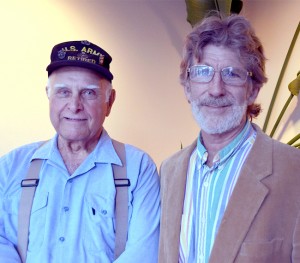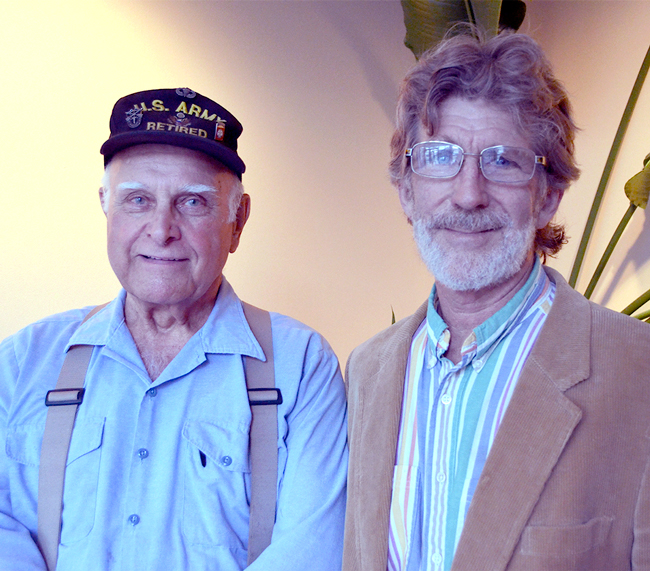Mayor offended by request for support
“You are not thinking about the impact it is going to have in my town. I am taking offense. I have kids here, and I swim in that river and I don’t like arsenic.”
Patrick Plumb, Mayor
City of Tonasket
TONASKET – Dan Isaac of Tonasket and Joseph Enzensperger of Oroville presented a report on the economic risks of Enloe Dam to the Tonasket City Council Tuesday, July 26. Mayor Patrick Plumb gave them the floor for a long and fact-filled presentation before telling them he was offended by their request for support, due to possible contamination of Tonasket’s water should the dam be removed.

Isasc and Enzensperger’s presentation was based partly on an economic report submitted July 1 to Columbia River Bioregional Education Project (see July 21 issue of Gazette-Tribune or view the report at www.columbiana.org). The report, prepared by Anthony Jones of Rocky Mountain Econometrics, estimates power produced by Enloe Dam will cost anywhere from $83 per milliwatt hour (MWH) to $149 MWH, nearly four times the cost of power on the open market.
Enzensperger said the cost of re-powering the dam has gone from the original estimate of $31 million to an estimated $60 million today. Enzensperger said it was not the cost of building it that worried him the most, but the cost of maintaining it at a loss, and as the interest accumulates, the debt would grow to $118 million by 30 years out.
“The interest on the principal would grow beyond the value of the product,” said Enzensperger, adding that by law the PUD could not claim bankruptcy, further ensuring the rate payers would have to shoulder the burden.
“The county commissioners talk about wanting a redundant source of energy, but Enloe Dam would provide a very insignificant portion of Oroville’s use,” said Enzensperger, “between 20 and 40 percent, when the river is at the high peak flow.”
Isaac spoke next, saying he first began following the PUD when they began putting smart meters on homes and Isaac had concerns regarding radiation, privacy and lack of security on data collected.
“I began to become aware of the attitude of the commissioners and management at the PUD. I was a concerned citizen asking for answers and they brushed me away. They didn’t want any outside information,” said Isaac.
He said he then became aware of the dam re-electrification project, with his biggest concerns being “they didn’t have an adequate amount of water to keep the dam going, and silt destroys the mechanisms, making it expensive to keep the dam running.”
Isaac said PUD commissioners put the burden on taxpayers, specifically those protesting re-electrification, of finding a lead agency to take over decommissioning the dam and to take on full responsibility for the cost of removal of the dam. Isaac said he questioned the reason the PUD would not allow any of the agencies that came forward as possible lead agencies to sample the soil behind the dam. He also said when NOAA and the National Wildlife Fisheries met with the PUD to see about taking over removal of the dam, they were told by PUD manager John Grubich and the commissioners they would need to give the PUD $13 million first, putting the “issue of dam removal on the back shelf.”
Isaac said when the econometrics report was presented, the PUD would not take it into consideration.
“I’ve been in business, and if someone said, ‘Dan, we have looked at it and costs have gone up 35 percent,’ I’m going to stop and check it out, but they never extended us the courtesy,” said Isaac, adding, “I have become disillusioned; we have a public agency but the PUDs of Washington State have no policing agency. They can do what they want.”
A mayor’s protests
After hearing their presentation, Plumb asked Isaac and Enzensperger, “After we tear that dam out, who is the first city to get hit by arsenic?” then answered his own question by saying the first beneficiary after the Similkameen River hits the Okanogan River is Tonasket.
Washington State DOE currently has a Water Quality Improvement Project in place on the Similkameen River for arsenic, and the Similkameen River contributes about 75 percent of combined flow into the Okanogan River.
“You are not thinking about the impact it is going to have in my town,” said Plumb. “I am taking offense. I have kids here, and I swim in that river and I don’t like arsenic.”
According to a 2004 report by the DOE, arsenic levels are high in the Similkameen due to a legacy of mining in British Columbia between Hedley and the U.S. border. Because the DOE determined the Similkameen to naturally exceed the EPA arsenic criteria upstream of areas disturbed by mining, the total maximum daily load (TMDL) is set equal to the natural background concentration of arsenic.
“That study was done based on the dam remaining in place. If there were a proposal for dam removal, a number of issues could be raised by releasing that water,” said Joye Redfield-Wilder with the DOE Monday, Aug. 1. “Assessing the sediment and the impacts of removal of the dam would need to be done before the dam was removed, and arsenic behind it would be a concern.”
DOE water quality assessment categories range from 1-5, with 1 meeting standards for clean water and 5 designated to polluted waters in need of a TMDL standard or other water quality project. Category 4 is for polluted waters that do not require a TMDL, either because one is already in place, another pollution control program is in place or a more complex solution is required to restore a stream to natural conditions.
Currently, the Similkameen River is at a level 4 for arsenic, with a TDML in place; and at a category 5 for temperature and PCBs. The Okanogan River is categorized at 5 for temperature, PCBs and DDTs; and at level 4 with TMDLs already in place for PCBs and DDTs.
“Do your research,” said Plumb.
Plumb also asked Isaac and Enzensperger if they knew who Enloe was.
Eugene Enloe, president of the Okanogan Valley Power Company, paid $150,000 of his own money toward the $350,000 cost of constructing the dam between 1919-1920. In 1923 Enloe sold the dam and the power plant to Washington Water Power Company (WWPC). WWPC was purchased by the Okanogan County PUD in 1942. In 1958, PUD ceased operations at Enloe because power was available and more affordable through the Bonneville Power Administration (BPA).
Along with power from the BPA, Okanogan PUD receives power from Wells Dam and Energy Northwest.
A consortium of 28 public utilities, Energy NW owns and operates a variety of power generating sources including nuclear, wind, hydro and solar. The Nine Canyon Wind Project can generate up to 95.9 megawatts of power, providing enough electricity, on average, to power over 10,000 households. As one of the largest participants, Okanogan PUD has a 24 percent share of energy output from Nine Canyon Wind Project.
“Now they want to sink money into a dam that will only produce 4.5 MWH,” said Isaac. “We are committed to giving 48 percent of that power to the tribe at cost. That leaves not even enough power being generated at Enloe Dam for the lower portion of Oroville.”
Mayor offended by request for support




